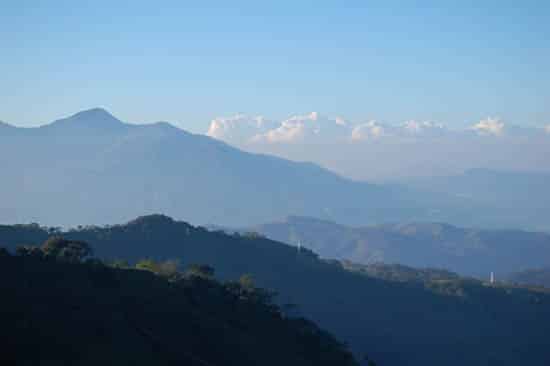Adding Depth To A Painting
Leonardo da Vinci – The Virgin of the Rocks (detail), 1491-1508
Why do mountains look blue in the distance?
Take y'all e'er wondered why a colina, that yous know is covered in green trees, looks purple or blue when viewed from a long distance abroad?
Trying to create a sense of depth and altitude in your landscape painting is central for creating realism in your paintings.
The simplest style to exercise this is with Aeriform perspective…

What is aeriform perspective?
Aerial perspective is the optical result that the atmosphere has on objects viewed at a long altitude.
For example, in the daytime, a mountain range will commonly announced bluer and lighter as it gets further and further away from us.
The air in the atmosphere contains various impurities and these human activity every bit a filter stopping sure wavelengths of light reaching our eyes.
This gives the illusion of a change of color and value.
Cool colours like blues and greens get through the 'filter' of air more than easily than the warm colours and so mountains unremarkably appear bluer.
Leonardo da Vinci noticed and studied that as a landscape recedes from the viewer its colours and tones alter due to the nature of the atmosphere.
You lot can run across this in his painting above where he has cool blue muted mountains in the background, and warm browns in the foreground.
Information technology is sometimes referred to as atmospheric perspective.
What effect does aerial perspective accept on landscape painting?
Change in colour – A green tree volition quickly announced purple, so blue as information technology receded into the altitude.
Change in tone – Everything gets paler, the temper not but affects the perceived colour in front of us only the tones, how light or how dark, each area of the mural is. The changes are most noticeable in the dark tones, (just like the dark colour tones)

You can see in this photo how obvious, now it'southward in black and white, the tonal value changes are.
It is also useful to note how the crispness of line as well alters, making the very back mountain quite blurry.
Pro tip: It is often a good tip when painting to mistiness the furthest mountain into the sky, You can blur it more than yous would initially call back and the viewer will 'create' the mount in their heed.
5 points to remember
- As the distance between you and the mountain increases, the contrast between the mountain and its background (usually sky) decreases.
- The farther away a mountain is the less detailed information technology becomes.
- The color becomes less and less saturated (intense) equally it disappears into the distance and becomes closer to the background colour. Every bit objects are viewed at increasing distances the colour alter effect is more pronounced, and (if viewed in the twenty-four hour period) progressively from purple to blue. This will requite the illusion of depth.
- The elements most altered by aerial perspective are the dark tones, east.grand: a dark dark-green will change more dramatically than a lite green.
- warm and cool – Use the ability of warm and colours to add fifty-fifty more depth. Add together a red highlight in the foreground to bring your viewers gaze forrad and to heighten the event. Warm in the foreground cools in the background
Aerial perspective example:
Dark Light-green forest scene on a articulate, sunny twenty-four hour period
Foreground: low-cal green highlights – dark dark-green shadows
Middle basis: libation green (towards blue)- light-green/imperial hue to the shadows
(the lighter areas volition also change only only a little cooler green, rather than a complete change in hue)
Far Distant: calorie-free purple/blue highlights – blue shadows with a majestic/violet shade
Very far distance (l miles) about white highlight – stake blueish shadows
Everything gets lighter in value as the distance from the viewer increases, as the landscape hits the horizon line information technology is ofttimes very like in value to the sky.

Will Kemp, Scottish landscape, 2011
The areas that are lighter in value nearly the front of the scene will hold onto their value for longer, the darks will plow to midtone speedily. Pure whites agree on to their value for a long altitude and then you tin nevertheless employ titanium white to point houses in the far distance as in the painting above.
A note on clouds


John Lawman, Harwich Lighthouse, 1820
Pro tip: Clouds abound darker as they recede, instead of lighter, and they grow warmer instead of cooler. So on a clear mean solar day with clouds in the heaven, the clouds become yellow as they recede, and those way off in the distance will be pink.
You might also similar:
one. How to draw perspective for beginners
two. The secret of good limerick
Adding Depth To A Painting,
Source: https://willkempartschool.com/how-to-instantly-add-depth-to-your-mountains-in-acrylic-landscape-painting/
Posted by: doylecamble.blogspot.com


0 Response to "Adding Depth To A Painting"
Post a Comment